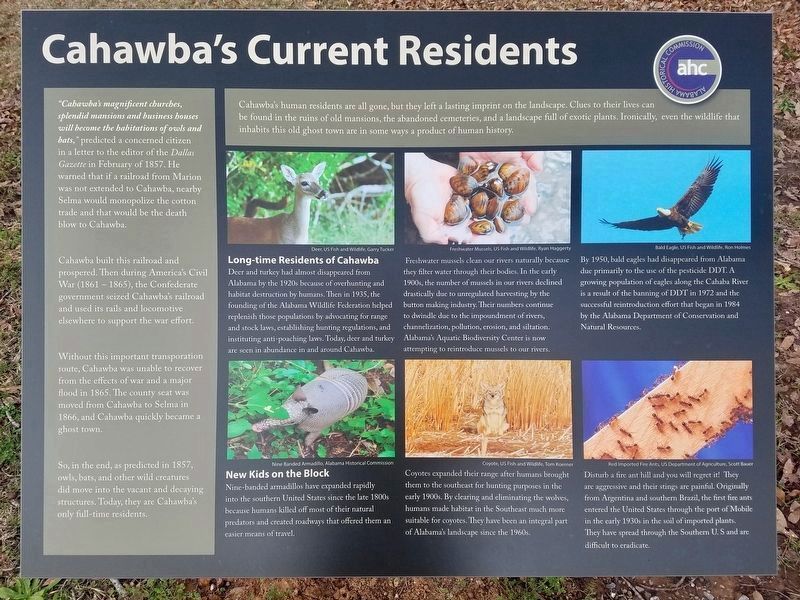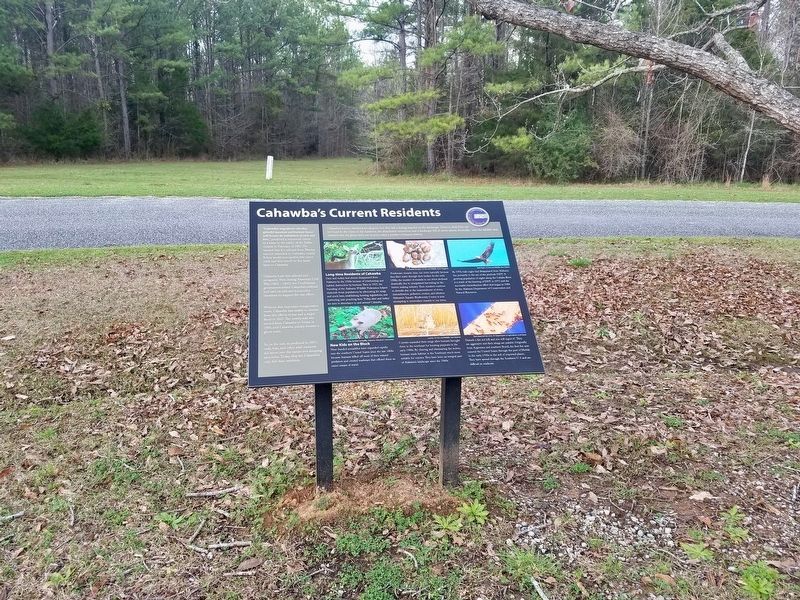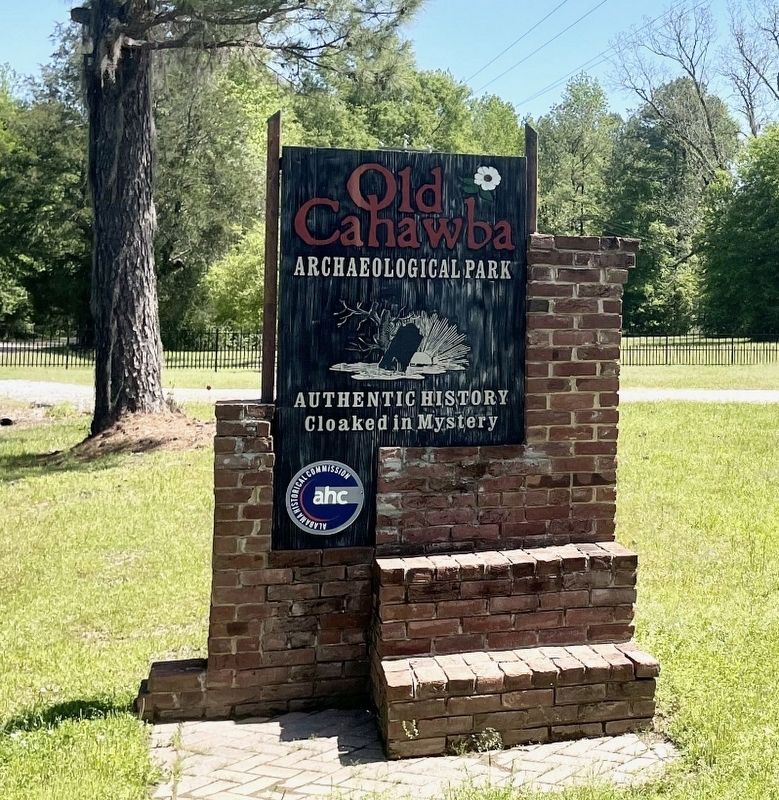Cahaba in Dallas County, Alabama — The American South (East South Central)
Cahawba’s Current Residents
"Cahawba's magnificent churches, splendid mansions and business houses will become the habitations of owls and bats," predicted a concerned citizen in a letter to the editor of the Dallas Gazette in February of 1857. He warned that if a railroad from Marion was not extended to Cahawba, nearby Selma would monopolize the cotton trade and that would be the death blow to Cahawba.
Cahawba built this railroad and prospered. Then during America's Civil War (1861-1865), the Confederate government seized Cahawba's railroad and used its rails and locomotive elsewhere to support the war effort.
Without this important transportation route, Cahawba was unable to recover from the effects of war and a major flood in 1865. The county seat was moved from Cahawba to Selma in 1866, and Cahawba quickly became a ghost town.
So, in the end, as predicted in 1857, owls, bats, and other wild creatures did move into the vacant and decaying structures. Today, they are Cahawba's only full-time residents.
Cahawba's human residents are all gone, but they left a lasting imprint on the landscape. Clues to their lives can be found in the ruins of old mansions, the abandoned cemeteries, and a landscape full of exotic plants. Ironically, even the wildlife that inhabits this old ghost town are in some ways a product of human history.
Long-time Residents of Cahawba
Deer and turkey had almost disappeared from Alabama by the 1920s because of overhunting and habitat destruction by humans. Then in 1935, the founding of the Alabama Wildlife Federation helped replenish those populations by advocating for range and stock laws, establishing hunting regulations, and instituting anti-poaching laws. Today, deer and turkey are seen in abundance in and around Cahawba.
Freshwater mussels clean our rivers naturally because they filter water through their bodies. In the early 1900s, the number of mussels in our rivers declined drastically due to unregulated harvesting by the button making industry. Their numbers continue to dwindle due to the impoundment of rivers, channelization, pollution, erosion, and siltation. Alabama's Aquatic Biodiversity Center is now attempting to reintroduce mussels to our rivers.
By 1950, bald eagles had disappeared from Alabama due primarily to the use of the pesticide DDT. A growing population of eagles along the Cahaba River is a result of the banning of DDT in 1972 and the successful reintroduction effort that began in 1984 by the Alabama Department of Conservation and Natural Resources.
New Kids on the Block
Nine-banded armadillos have expanded rapidly into the southern United States since the late 1800s because humans killed off most of their natural predators and created roadways that offered them an easier means of travel.
Coyotes expanded their range after humans brought them to the southeast for hunting purposes in the early 1900s. By clearing and eliminating the wolves, humans made habitat in the Southeast much more suitable for coyotes. They have been an integral part of Alabama's landscape since the 1960s.
Disturb a fire ant hill and you will regret it! They are aggressive and their stings are painful. Originally from Argentina and southern Brazil, the first fire ants entered the United States through the port of Mobile in the early 1930s in the soil of imported plants. They have spread through the Southern U. S and are difficult to eradicate.
Erected by the Alabama Historical Commission.
Topics. This historical marker is listed in these topic lists: Animals • Railroads & Streetcars • War, US Civil. A significant historical month for this entry is February 1857.
Location. 32° 19.185′ N, 87° 6.274′ W. Marker is in Cahaba, Alabama, in Dallas County. Marker can be reached from the intersection of Cahaba Road and Capitol Street, on the right when traveling north. Located at the Old Cahawba Archaeological Park visitor center parking lot. Touch for map. Marker is at or near this postal address: 9518 Cahaba Rd, Orrville AL 36767, United States of America. Touch for directions.
Other nearby markers. At least 8 other markers are within walking distance of this marker. Cahawba's Changing Landscape (a few steps from this marker); Black Belt Transformations (a few steps from this marker); Who Lived Here? (approx. 0.3 miles away); Anna Gayle Fry House (approx. 0.3 miles away); Old Cemetery (approx. 0.4 miles away); Methodist Church (approx. 0.4 miles away); Memorials for Prisoners of War (approx. 0.4 miles away); Lafayette's Tour (approx. 0.4 miles away). Touch for a list and map of all markers in Cahaba.
More about this marker. The third paragraph contains a minor typo: "transporation" vs. "transportation".
Credits. This page was last revised on April 22, 2024. It was originally submitted on April 21, 2024. This page has been viewed 61 times since then. Last updated on April 21, 2024. Photos: 1, 2. submitted on April 21, 2024. 3. submitted on April 21, 2024, by Mark Hilton of Montgomery, Alabama. • Bill Pfingsten was the editor who published this page.


